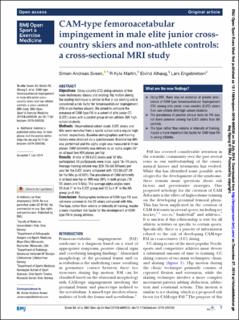| dc.contributor.author | Sveen, Simen Andreas | |
| dc.contributor.author | Martin, RK | |
| dc.contributor.author | Alhaug, Eivind | |
| dc.contributor.author | Engebretsen, Lars | |
| dc.date.accessioned | 2020-04-28T08:49:21Z | |
| dc.date.available | 2020-04-28T08:49:21Z | |
| dc.date.created | 2019-08-26T10:51:16Z | |
| dc.date.issued | 2019 | |
| dc.identifier.citation | BMJ Open sport & exercise medicine. 2019, 5(1), e000530. | en_US |
| dc.identifier.issn | 2055-7647 | |
| dc.identifier.uri | https://hdl.handle.net/11250/2652728 | |
| dc.description | This is an open access article distributed in accordance with the Creative Commons Attribution Non Commercial (CC BY-NC 4.0) license, which permits others to distribute, remix, adapt, build upon this work non-commercially, and license their derivative works on different terms, provided the original work is properly cited, appropriate credit is given, any changes made indicated, and the use is non-commercial. See: http://creativecommons.org/licenses/by-nc/4.0/. | en_US |
| dc.description.abstract | OBJECTIVES: Cross-country (CC) skiing consists of two main techniques: classic and skating. Hip motion during the skating technique is similar to that in ice skating and is considered a risk factor for femoroacetabular impingement (FAI) in ice hockey players. We aimed to compare the presence of CAM-type FAI in a cohort of elite junior CC (EJCC) skiers with a control group of non-athlete (NA) high school students. METHODS: Observational cohort study: EJCC skiers and NAs were recruited from a sports school and a regular high school, respectively. Baseline demographics and training history were obtained via a questionnaire. Bilateral hip MRI was performed and the alpha angle was measured in three planes. CAM deformity was defined as an alpha angle>55° on at least two MRI planes per hip. RESULTS: A total of 20 EJCC skiers and 10 NAs participated. All participants were male, aged 16-19 years. Average training volume was 528.10±68.34 hours per year for the EJCC skiers compared with 153.50±57.09 for the NAs (p<0.001). The prevalence of CAM deformity in at least one hip on MRI was 50% in both groups (10 CC skiers and 5 NAs). The average alpha angles were 52.4±6.1° in the EJCC group and 52.5±4.9° in the NA group (p=0.94). CONCLUSION: Radiographic evidence of CAM-type FAI was not more common in the CC skiers compared with NAs. The type, rather than volume or intensity of training, maybe a more important risk factor for the development of CAM-type FAI in young athletes. | en_US |
| dc.language.iso | eng | en_US |
| dc.relation.uri | https://bmjopensem.bmj.com/content/bmjosem/5/1/e000530.full.pdf | |
| dc.subject | CAM | en_US |
| dc.subject | FAI | en_US |
| dc.subject | athlete | en_US |
| dc.subject | cross-country | en_US |
| dc.subject | femoroacetabular impingement | en_US |
| dc.title | CAM-type femoroacetabular impingement in male elite junior cross-country skiers and non-athlete controls: A cross-sectional MRI study | en_US |
| dc.type | Peer reviewed | en_US |
| dc.type | Journal article | en_US |
| dc.description.version | publishedVersion | en_US |
| dc.rights.holder | © Author(s) (or their employer(s)) 2019. | en_US |
| dc.source.pagenumber | 6 | en_US |
| dc.source.volume | 5 | en_US |
| dc.source.journal | BMJ Open sport & exercise medicine | en_US |
| dc.source.issue | 1 | en_US |
| dc.identifier.doi | 10.1136/bmjsem-2019-000530 | |
| dc.identifier.cristin | 1718632 | |
| dc.description.localcode | Seksjon for idrettsmedisinske fag / Department of Sports Medicine | en_US |
| cristin.unitcode | 150,34,0,0 | |
| cristin.unitname | Seksjon for idrettsmedisinske fag | |
| cristin.ispublished | true | |
| cristin.fulltext | original | |
| cristin.qualitycode | 1 | |
